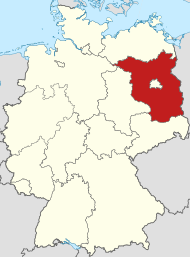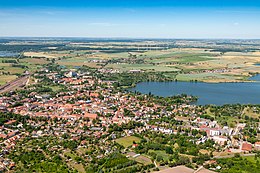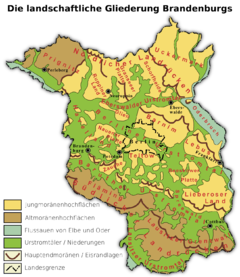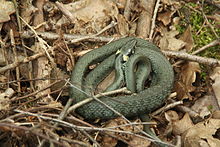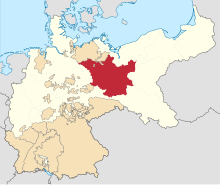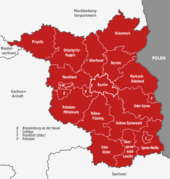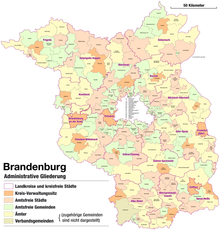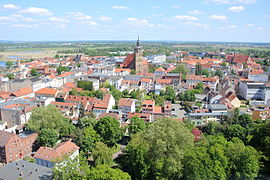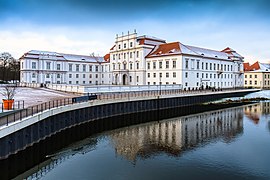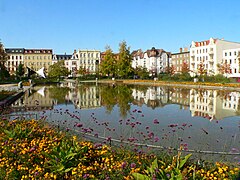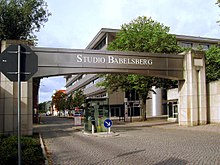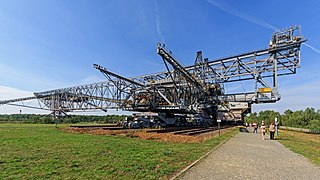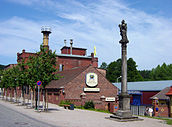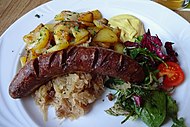Brandenburg
Brandenburg [ ˈbʁandn̩ˌbʊʁk ] ( Lower Sorbian Bramborska ; Low German Brannenborg ; colloquially the Mark ) is a country in the northeast of the Federal Republic of Germany . The state capital and most populous city is Potsdam , other important centers are Cottbus , Brandenburg an der Havel and Frankfurt (Oder) .
Brandenburg surrounds the German capital Berlin in its center and together with it forms the European metropolitan region Berlin / Brandenburg , in which around 6 million people live. More than a third of the area of Brandenburg is taken up by nature parks, forests, lakes and water areas.
The founding year of the Mark Brandenburg is 1157, in which the Ascanian Albrecht the Bear appropriated the area with the reconquest of the Brandenburg and made it part of the Holy Roman Empire . From 1415 to 1918 the region was under the rule of the Hohenzollern family . From 1701 to 1946 the mark developed into the heartland of Prussia . The province of Brandenburg , created in 1815, existed until 1947. At this time, Brandenburg reached its greatest territorial expansion. After 1945, which was east of the part Elbe and west of the Oder and Neisse first time a state of Brandenburg founded that later but in different DDR - districts was divided. The part to the east of it came to the People's Republic of Poland and today largely forms the Lubusz Voivodeship , while a smaller part belongs to the West Pomeranian Voivodeship . Brandenburg was then re-established in 1990 as the “Land” of the Federal Republic of Germany .
The main branches of industry in Brandenburg include a. agriculture, the energy sector, aerospace industries, tourism and the film industry.
geography
The state of Brandenburg is located in the northeast of the Federal Republic of Germany . It borders Saxony in the south, Saxony-Anhalt in the west, Lower Saxony in the northwest , Mecklenburg-Western Pomerania in the north and the Republic of Poland in the east . Brandenburg has five exclaves that lie within the borders of Saxony-Anhalt and belong to the communities Buckautal and Ziesar . With a total area of 29,654 km², Brandenburg is the fifth largest state in Germany after the area and with a maximum diagonal extension of 291 km, a north-south extension of 244 km and an east-west extension of 234 km, it is also the largest of the new states . The core area of Brandenburg is still referred to by the historical name of Mark Brandenburg .
In terms of economic geography, the states of Berlin and Brandenburg together form the European metropolitan region of Berlin / Brandenburg . In the capital region Berlin-Brandenburg metropolitan area called live about six million inhabitants. The agglomeration of Berlin with 4.4 million inhabitants, whose closer interlinked area around Berlin is known as the “bacon belt”, includes Berlin and parts of Brandenburg. This corresponds to the orientation of the infrastructure , which is typical for Brandenburg, such as motorways and main railway lines, towards the federal capital Berlin, which is located in the form of an island.
Outside of the larger cities such as Brandenburg an der Havel in the west, Frankfurt (Oder) in the east and Cottbus in the south, the second most populous city after Potsdam , the country is relatively sparsely populated. The south of the country is formed by Lower Lusatia , small parts of Upper Lusatia and the Elbe-Elster-Land . The state of Brandenburg includes the Havelland to the west , the Teltow to the south of Berlin and the Barnim to the northeast . At the borders lie in the north the Oberhavel (with Fürstenberger Werder , which historically belonged to Mecklenburg until 1950 ), in the north-west the Prignitz , in the north-east the Uckermark , in the east the Oderbruch and in the south-west the Fläming .
Geology and soils

The state of Brandenburg lies in the north German lowlands and was decisively shaped on the surface of the earth by the repeated advances of the Scandinavian inland ice during the Ice Age . Therefore, deposits occur almost exclusively during the cold and warm periods. Most common are glacial till and meltwater sands . The elements of the glacial series are typical of the surface shaping . The glacial valley is one of their landscapes . These show a globally unique accumulation in this country: Netze-Randow-, Thorn-Eberswalder , Warsaw-Berlin , Glogau-Baruther and Breslau-Bremer Urstromtal.
Due to the diversity of the Ice Age deposits in Brandenburg, the resulting soil associations are very diverse. Their productivity ranges from extremely low in nutrients and sterile to very fertile. Nevertheless, in terms of area, especially in central and southern Brandenburg, the nutrient-poor sandy soils predominate, which give the country its characteristic character.
Brandenburg is considered a raw material supplier, especially in the south, along the Lusatian border wall there are large lignite deposits , in the southeast around Spremberg deep copper deposits have been found. Crude oil is occasionally detected in the area.
Landscapes
The main large landscapes of Brandenburg are from north to south the Baltic or northern ridge , the zone of the plates and glacial valleys and the southern ridge .
Heights of over 100 m are reached on both ridges. The southern ridge, which extends from the Harburg mountains to Poland ( Katzengebirge ), is attributed to the Fläming in Brandenburg and its eastern continuation, the Lausitz border wall with the Muskau folds . On average, it is higher than the Baltic Ridge. That stretches from Jutland to the Baltic States . The Mecklenburg Lake District , which extends into Brandenburg, belongs to it. The rivers Havel , Rhin and Dosse have their source in this lake district . In the southeast with the Lausitzer Urstromtal (part of the Breslau-Bremer Urstromtal) and northeast with low-lying parts of the Uckermark, Brandenburg extends beyond the aforementioned mountain ranges.
Between the ridges lies the area of the Central Brandenburg plateaus and glacial valleys . Extensive lowlands such as the Rhinluch , the Havelländische Luch and the chain of lakes in the middle Havel delimit the islands rising up from them like Barnim , Nauener Platte and the Ländchen . The level of the glacial valleys and the associated side valleys show a slight gradient from southeast to northwest. It ranges from around 60 m on the Neisse to less than 20 m at the mouth of the Havel. The average height of the plates decreases from east to west from over 100 m on the Oder to 40 m to 50 m in the west. The Oder Valley lies particularly deep in the northeast, almost at sea level.
In terms of landscape, the difference between the old moraine and the young moraine land is striking . While there are almost no natural lakes in the south and in the Prignitz , the newly glaciated area is rich in lakes. There are regional differences. Many high ground moraine areas, such as the Barnim or the Lebus region, have few lakes. On the other hand, areas such as parts of the western Uckermark, in which there was extensive spillage and conservation of dead ice blocks , are rich in lakes.
climate
The state of Brandenburg is located in the transition area between the oceanic climate in Western Europe and the continental climate in the east. Due to the relatively small height differences, the climatic differences within the country are rather small, but can be felt in certain weather conditions.
The annual average temperature is around 9 ° C. The coldest month is January with an average of −1 ° C. The warmest month is July with an average temperature of 18 ° C. In terms of air temperature, a slight increase in continentality is already noticeable from Prignitz in the northwest to Niederlausitz in the southeast . Especially in the winter months when windless radiation weather conditions the Lausitz usually much colder than the Prignitz.
With an average annual total precipitation of less than 600 mm, Brandenburg is one of the driest, and perhaps the least precipitated, federal states. Usually the average annual precipitation is 550 mm. Only Prignitz in the northwest and some high areas such as the Hohe Fläming and the Hohe Barnim reach or exceed the 600 mm mark per year. A slight rain shadow is noticeable east of the high areas , so the low lying Oderbruch is one of the driest regions in Germany with less than 500 mm annual precipitation.
While winter and spring are comparatively dry, rainfall across the country falls mainly in the summer months. Nevertheless, pronounced dry phases can also occur in the warm season, during which the risk of forest fires increases sharply in Brandenburg . In 2018 there were 512 fires in Brandenburg's forests (an average of around 300 forest fires annually), including eleven major fires. The sun shines an average of 1600 hours a year.
In order to stabilize the forest for the requirements of climate change (including heavy rain and droughts), the state of Brandenburg spends 8.5 million euros annually (as of 2018) on a forest conversion program in order, among other things, to increase the number of different tree species in several age groups are.
Effects of climate change
In 2019, the temperature in Brandenburg was 1.3 degrees Celsius above the pre-industrial value and this value could rise to 3.8 degrees by the end of the century if the current development path is maintained. According to assumptions, Brandenburg will be more and more affected by extreme weather events, including longer periods of drought and locally occurring heavy precipitation events. Due to global warming , the sea level will probably rise by 80 to 100 cm by the turn of the century; thus the salt water border lies in the Lower Oder Valley.
Waters
Brandenburg is considered the most water-rich federal state in Germany. There are over 3000 naturally formed lakes , plus numerous artificially created ponds , quarry ponds and similar bodies of water . Furthermore, there are over 33,000 km of rivers , most of which are artificially created drainage ditches and other canals . On the other hand, the groundwater in Brandenburg is only very slowly renewed due to the lack of precipitation . The retention time of the water in the waters is therefore quite long.
Rivers
Larger rivers only touch Brandenburg at their borders. The Elbe (total length 1091 km) runs for a few kilometers in the extreme south and north-west of Brandenburg, where almost without exception it marks the state border. Only the 0.5 km² area around the ferry landing stage at the mouth of the Dahle, including a section of the federal highway 182 , which belongs to Mühlberg , represents the only area in Brandenburg on the left bank of the Elbe . The Oder (total length 866 km), together with the Neisse as its tributary, forms the entire eastern border of Brandenburg. Only the furthest north-eastern border kilometers are excluded.
The most important inland rivers in Brandenburg are the 334 km long Havel and the 400 km long Spree as their largest tributary. At the confluence of the river, the Spree is richer in water than the Oberhavel, with which the Spree and Unterhavel form a 560 km long river that runs mainly in Brandenburg (350 km of which are navigable). All other rivers in Brandenburg are small rivers and streams of regional importance. In northern Brandenburg the Stepenitz , Dosse , Rhin , Ucker and Finow are to be mentioned. In the middle part the Plane , the Nieplitz , the Panke , the (Jüterboger) Nuthe , the Notte and the Dahme have a certain meaning. The largest river in the south of Brandenburg is the Black Elster . Then rivers like the Kleine Elster , the Oelse or the Schlaube are to be named.
Lakes
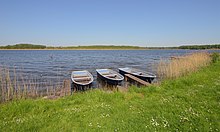
Due to its history in the Ice Age, Brandenburg is extremely rich in naturally formed lakes . There are more than 800 bodies of water with an area of more than one hectare. The largest natural lake in Brandenburg is the Schwielochsee with an area of 13.3 km² . This is followed by the Scharmützelsee (12 km²), the Unteruckersee (10.4 km²), the Parsteiner See (10 km²), the Ruppiner See (8.25 km²), the Schwielowsee (7.9 km²), the Werbellinsee (7, 8 km²) and the Grimnitzsee (7.8 km²). With almost 70 m deepest lake in the country and at the same time the one with the best water quality is the Great Stechlinsee .
In addition to the numerous natural lake areas in Brandenburg, there is one created by man: The Lusatian Lake District is created by flooding unused open-cast mining holes. With 13 km² the Senftenberger See is currently the largest body of water in it. In 2025 it will be Europe's largest artificial water landscape and Germany's fourth largest lake area. The Sedlitzer See (13.3 km²) will become the largest lake by then , and together with the Schwielochsee will be the largest lake in Brandenburg. The Spremberg dam is 6.7 km² and is the largest reservoir in Brandenburg.
Flora and fauna
In 2011 the primeval beech forests were added to the World Heritage List. Among others, the beech forest in the Grumsiner forest in the Schorfheide-Chorin biosphere reserve has been declared part of the world natural heritage. There are pronounced beech forests here, which are considered to be the remains of the extensive beech stands that used to exist in Central Europe.
The Lower Oder Valley National Park is home to the kingfisher and the reed warbler , one of the most endangered songbirds in Europe. Larger populations of this songbird species can otherwise only be found in the swamp and floodplain landscapes of Eastern Europe further to the east. White storks breed on the roofs of the surrounding villages. The very rare black storks can also be found , albeit very hidden, of which there are currently 3 to 5 breeding pairs. Rare bird species such as the lesser spotted eagle have also found a retreat there.
The meadows flooded in winter offer numerous migratory birds resting places. The whooper swan is one of the birds that can be observed here . The breeding birds of this national park include such rare meadow breeders as the corncrake , the ruff and the black- tailed godwit, and the oriole nests in the alluvial forests and deciduous forests on the slopes of the Oder . The largest breeding colony of the Black Tern is also located in the national park.
Wild boars , otters , beavers , wolves , raccoons , roe deer , red deer and sea eagles have settled in Brandenburg as permanent species .
Nature parks
A total of 15 so-called large protected areas are designated in Brandenburg. They take up around a third of the country's area. These include the Lower Odertal National Park (106 km²) and the three areas designated as biosphere reserves by UNESCO: the Elbe-Brandenburg River Landscape Reserve (533 km²), the Schorfheide-Chorin Biosphere Reserve (1291 km²) and the Spreewald Biosphere Reserve (474 km²). In addition, there are eleven nature parks : Barnim Nature Park (750 km²), Dahme-Heideseen Nature Park (594 km²), Hoher Fläming Nature Park (827 km²), Märkische Schweiz Nature Park (204 km²), Niederlausitzer Heidelandschaft Nature Park (490 km²), Niederlausitzer Landrücke Nature Park ( 580 km²), Nuthe-Nieplitz Nature Park (623 km²), Schlaubetal Nature Park (225 km²), Uckermärkische Seen Nature Park (895 km²), Westhavelland Nature Park (1315 km²), Stechlin-Ruppiner Land Nature Park (1080 km²).
Wooded area at the Werbellinsee
Orchard meadow in the Niederlausitzer Heidelandschaft nature park
Small ham lake in the Schlaubetal nature park
Wild geese at the Blumberg fish ponds in the Schorfheide-Chorin biosphere reserve
history
The beginnings of Brandenburg
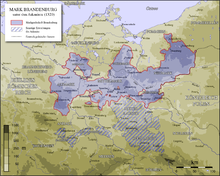



The Teutons who settled in what is now the state of Brandenburg largely left the area during the migration of peoples in the 4th to 6th centuries . In the 7th / 8th In the 19th century, Slavs immigrated in several waves . In the winter of 928/929 under Heinrich I , an East Franconian army conquered Brandenburg , the center of the Heveller land . These were now subject to tribute . Otto I intensified the previously loose involvement and established the Saxon East Mark mentioned in 937 . A few years after his coronation as Emperor of the (Holy) Roman Empire in 962, the dioceses of Brandenburg , Havelberg and Meißen were established .
In 965 the Ostmark was divided. The south with u. a. the Mark Lausitz (later Niederlausitz ) remained under German rule. In the North Mark , however, it ended with the Slav uprising of 983 . Despite repeated attempts at conquest, East German settlement and Christianization stopped here for over 150 years. (In the details, the development looked more differentiated.) From the 1st third of the 12th century, Pomerania , Poland , Silesia , Mark Meissen , Erzmagdeburg , German royal and Saxon noble houses struggled here for supremacy. The Polish claims manifested themselves e.g. B. in the establishment of the diocese of Lebus in 1124. Ultimately, a noble family should prevail, which derived its name from the castle Aschersleben .
Albrecht the Bear from the House of Ascania developed a close relationship with Pribislaw . The Prince of Heveller died childless in 1150. Albrecht I inherited his land, who took over Brandenburg relatively peacefully. Jaxa , possibly the Prince of the Sprewanen who was under Polish sovereignty , saw himself as a relative of Pribislaw disinherited. In the spring of 1157 the castle gate was opened to him by means of bribery and he marched in with a Polish army in a flash. The reconquest succeeded Albrecht I, supported by other Saxon aristocrats and the Archbishop of Magdeburg, Wichmann , on June 11, 1157. This date is generally considered to be the birthday of the Mark Brandenburg .
With the gradual expansion of sovereignty and territory, the Ascanians were largely able to oust or integrate their rivals. Their empire direct positions more or less only preserved the rule of Ruppin and the three Hochstifte Brandenburg , Havelberg and Lebus. The Slavs were occasionally resettled, for example when the Chorin monastery was founded . As a rule, they participated in the development of the state on an equal footing . At the end of the 12th century grew with the Electorate rich political significance of the Margrave of Brandenburg . From 1302/1304 these also ruled in the Lausitz region. In 1320 the Brandenburg line of the Ascanians died out.
The power politics of the Wittelsbach and Luxembourgers continued to link the history of the two brands . From a Markbrandenburg point of view, the times of the Wittelsbacher (1323-1373) and Luxemburger (1373-1415) were a phase of rather weak sovereigns. Only the brief stabilization under Charles IV stood out. Under his reign , first the Mark Lausitz (1370), then the Mark Brandenburg (1374) were included in the states of the Bohemian Crown .
From 1411, finally from 1415, the Mark Brandenburg was subordinate to the Hohenzollern family . They successfully pacified the country and restored central power. The Mark Brandenburg, which was destroyed and impoverished by the Thirty Years War , has been gradually rebuilt by Friedrich Wilhelm since 1640 . This process was briefly interrupted by the invasion of the Swedes in 1674/1675 . However, the Great Elector and General Georg von Derfflinger achieved decisive victories in the battles at Rathenow , Nauen and above all at Fehrbellin .
Brandenburg has enjoyed a continuous upswing since 1648, also supported by a strong Brandenburg army. In the 17th century, the state maintained close and cooperative relationships with its southern neighbor, the Electorate of Saxony .
Prussia (1701–1947)
From 1701 to 1946, the Mark Brandenburg shared the political history of the Prussian state as a whole . In 1701 the elector Friedrich III crowned himself. from Brandenburg to king in Prussia. As a result of the elector's rise in rank, only the names of state institutions such as the army, ambassadors and the authorities changed from “electoral Brandenburg” to “royal Prussian”. The importance of the central province of Mark Brandenburg with the residential landscape around Berlin and Potsdam grew all the more as Brandenburg-Prussia developed into a central, absolutist state with ambitions for Germany and Europe. Under King Friedrich I's rule from 1688 to 1713, the population of the Mark increased by about a third to more than 730,000 inhabitants in 1713. The number of cities rose to 120. The cities of Brandenburg an der Havel and Frankfurt an der Oder were among them the population of 10,000.
In the Seven Years' War from 1756 to 1763 the mark became a theater of war again. Austrian and Russian troops repeatedly penetrated the Mark and temporarily occupied Berlin.
Friedrich II devoted himself in the second half of his reign to the reconstruction and development of the Mark. In the Rhing area, on the Dosse and Netze , he had drainage ditches built and the Plauer and Finow Canal dug as a connection between the Elbe and the Oder. Solid land was wrested from the Brandenburg marshes, Bruch and Luch and given to immigrants from Bohemia and veterans to settle. From 1770 to 1786 412 villages were founded in Kurmark and Neumark and 124,720 colonists found a new home. In the Oderbruch alone , 50 villages were created.
Brandenburg, together with Berlin (which was part of Brandenburg), formed the heartland of Prussia . In the Prussian administrative reforms after the Congress of Vienna in 1815, the province of Brandenburg was formed, whereby the Altmark was left out and the former Saxon areas of Lusatia were added. Berlin left the province of Brandenburg with the Greater Berlin Act of 1920.
In the final phase of World War II , after heavy defensive battles, the Red Army occupied the territory and the province of Brandenburg became part of the Soviet Occupation Zone (SBZ) in 1945 , but without the areas east of the Oder-Neisse line ( Neumark ) that fell to Poland (see also German-Polish border treaty 1990) and their German population was expelled . The Brandenburg state parliament met for the first time in autumn 1946 .
German Democratic Republic (1947–1990)
On February 6, 1947, the province went on in the new state of Brandenburg , which had been established as a member state of the future German Democratic Republic (GDR). The Free State of Prussia was dissolved shortly afterwards on February 25, 1947 by the Control Council Act No. 46 . The land had an area of 27,612 square kilometers. As early as 1949, with the founding of the GDR, the country's institutions largely lost their functions. In 1952, the state was effectively dissolved as part of the administrative reform of 1952 and essentially divided into the three new districts of Cottbus , Frankfurt (Oder) and Potsdam . The district of Perleberg fell to the district of Schwerin , the districts of Prenzlau and Templin to the district of Neubrandenburg .
Economically, the traditionally agricultural areas of the former Mark changed fundamentally in the 40 years of the GDR. Thus, among other things, the Niederlausitz industrial area was created, including the lignite power stations for energy production with a simultaneous expansion of lignite mining south and east of Cottbus, where 2/3 of the GDR's fuel production was located. In Ludwigsfelde there was an important truck production , in Teltow electrical industry, in Schwedt / Oder oil and paper industry, in Brandenburg / Havel and Eisenhüttenstadt steel industry, in Wildau heavy machinery, in Rathenow (since 1801) optical industry in Wittstock / Dosse and in Premnitz Textile industry.
Federal Republic of Germany (since 1990)

On October 3, 1990, the state of Brandenburg was re-established by merging the districts of Cottbus (excluding the districts of Hoyerswerda , Jessen and Weißwasser ), Frankfurt (Oder) and Potsdam plus the districts of Perleberg , Prenzlau and Templin . On October 26, 1990, the new Brandenburg State Parliament met for the first time. The partner state of Brandenburg for setting up the new structures was North Rhine-Westphalia .
From 1990 to 2002, Prime Minister Manfred Stolpe shaped the political development of Brandenburg. In May 1996, in a referendum , the Brandenburgers decided against the unification of the states of Berlin and Brandenburg. The required minimum approval ( quorum ) of 25% of the eligible voters was not achieved.
In 2004, the Brandenburg state government began realigning funding, turning away from economic development based on the watering can principle . Only sustainable industries that had already gained a foothold in the individual regions and promised growth potential should be funded. With the involvement of 26 cities and municipalities, 15 regional growth centers were created and the sectors of expertise eligible for funding were defined for each.
After 1990 there were some territorial changes according to the State Treaty of May 9, 1992, which came into force on July 1, 1992. The municipalities of Bagemühl, Grünberg, Nechlin, Woddow, Wollschow-Menkin and the city of Brüssow of the Pasewalk district as well as the municipalities of Fahrenholz, Güterberg, Jagow, Lemmersdorf, Lübbenow, Milow, Trebenow, Wilsickow, Wismar and Wolfshagen of the Strasburg district were incorporated into the existing municipality - and district boundaries separated from the state of Mecklenburg-Western Pomerania and incorporated into the state of Brandenburg. In addition, the municipalities of Besanders , Eldenburg , Lanz , Lenzen (Elbe) , Mellen and Wootz were spun off from Mecklenburg-Western Pomerania in the existing municipality and district boundaries and incorporated into the state of Brandenburg. The municipalities of Dambeck and Brunow as well as the districts of Pampin and Platschow of the municipality of Berge were spun off from the state of Brandenburg in the existing municipal and district boundaries and incorporated into the state of Mecklenburg-Western Pomerania, Pampin and Platschow became districts of Ziegendorf .
population

The state of Brandenburg has 2,484,826 inhabitants (as of December 31, 2015). This puts Brandenburg in tenth place in a comparison of the federal states. With a population density of 83.8 inhabitants per square kilometer, it is the least populated German state after Mecklenburg-Western Pomerania . Around one million people live in the Berlin agglomeration . The areas further outside have a significantly lower population density of sometimes less than 25 inhabitants per square kilometer. In the state of Brandenburg, the capital Potsdam and Cottbus are the only large cities . According to the statistics office, 19,339 children were born in the country in 2014. That is almost 1,000 newborns or 5.3 percent more than in 2013.
In 2015, the share of the foreign population was 3.6%. In total, around 6% of citizens had a migration background in 2016 ; the figure for Germany is around 20%. Around 20,000 Sorbs live in the south-eastern districts and in Cottbus .
The average life expectancy in the period 2015/17 was 77.6 years for men and 83.1 years for women. The men are 11th among the German federal states, while women are 7th. Regionally in 2013/15 Potsdam (expectation of the total population: 81.67 years), Potsdam-Mittelmark (81.63) and Dahme-Spreewald (81.19) had the highest, as well as Elbe-Elster (79.48), Oberspreewald-Lausitz (79.12) and Prignitz (79.09) have the lowest life expectancy.
With 1.64 children per woman in 2017, Brandenburg had the highest total fertility rate among the German federal states.
Population development
The total number of inhabitants in what is now the state of Brandenburg was relatively constant in the second half of the 20th century. Since 2000, however, the population has been falling steadily, with some strong regional differences. The Brandenburg area in the metropolitan region of Berlin / Brandenburg grew by around 27 percent to one million inhabitants between 1994 and 2005, while more remote cities and communities lost their inhabitants.
After 1945 the population of today's Brandenburg region, which from 1952 essentially corresponded to the three districts of Cottbus , Frankfurt (Oder) and Potsdam , always fluctuated around the mark of 2.6 million inhabitants. The population initially decreased from 2.7 to 2.6 million people between 1955 and 1964. After a slight increase, the population was around 2.65 million by the end of the 1980s. This constancy conceals strong regional differences. While the municipal centers such as the district cities of Potsdam, Frankfurt (Oder) and Cottbus experienced a population increase, the number of inhabitants in rural areas fell continuously.
The opening of the inner German border after 1989 brought the Brandenburg region a population decline of 60,000 by the end of 1989; up to 1995 there were 100,000 fewer inhabitants before their number increased statistically to around 2.6 million in the following five years. This development, which ran counter to the general emigration trend in the new federal states , was due to the influx of numerous Berliners into the Berlin area surrounding Brandenburg.
As a result of the 2011 census , the population figures were corrected significantly downwards, the number of inhabitants fell below the 2.5 million mark. The purely statistical population decline was almost 50,000 people. According to Bertelsmann's 2011 Wegweiser Kommune extrapolation , the state's population could fall to 2.36 million by 2030 if the development remained the same (base years before 2010). This forecast predicts a population increase in the areas in Brandenburg near Berlin due to the strong growth of the agglomeration of Berlin .
Biggest cities
The population development in Brandenburg is listed in the following table as an example for cities and municipalities with more than 30,000 inhabitants (as of December 2018).
| City / municipality | district | Residents Dec. 31, 2010 |
Residents Dec. 31, 2018 |
Berlin metropolitan area |
|---|---|---|---|---|
| Potsdam | independent city | 156.906 | 178.089 | x |
| cottbus | independent city | 102.091 | 100.219 | |
| Brandenburg on the Havel | independent city | 71,778 | 72.124 | |
| Frankfurt (Oder) | independent city | 60,330 | 57,873 | |
| Oranienburg | Oberhavel | 41,810 | 44,512 | x |
| Falkensee | Havelland | 40,511 | 43,844 | x |
| Eberswalde | Barnim | 40,944 | 40,387 | |
| Bernau near Berlin | Barnim | 36,338 | 38,825 | x |
| King Wusterhausen | Dahme-Spreewald | 33,981 | 37,190 | x |
| Fürstenwalde / Spree | Oder-Spree | 32,468 | 31,941 | |
| Neuruppin | Ostprignitz-Ruppin | 31,599 | 30,846 | |
| Schwedt / Oder | Uckermark | 34,035 | 29,920 |
language
The official language in Brandenburg is German . Mainly High German , High German dialects of Lusatian-Neumärk and also Low German dialects of Mark-Brandenburg are spoken in the country. In the border area with Saxony , Osterländisch - a dialect of Upper Saxon - is also used, which is closely related to High German. In the Brandenburg Niederlausitz be lausitzische dialects spoken. That dialect and the dialect used in Berlin and its surrounding area can be assigned to East Central German. In Barnim the dialect Eberswalder Kanaldeutsch is common.
In some parts of Lower Lusatia, Lower Sorbian , a West Slavic language , is spoken by around 7,000-10,000 people with their own cultural history and has the status of a second official language in the Sorbs / Wends settlement area there .
English is occasionally used as the language of instruction at Brandenburg universities. The vocabulary of the dialects in Brandenburg is recorded and described in the Brandenburg-Berlin dictionary and (for the southern part of the country) in the dictionary of Upper Saxon dialects .
Religions and worldviews
Around 80% of the residents of Brandenburg were without religious belief in 2011.
Christianity
In 2014 around 17% of the residents of Brandenburg were members of a Protestant regional church , the majority of them in the Evangelical Church of Berlin-Brandenburg-Silesian Upper Lusatia . Since the borders of the regional churches differ from those of today's federal states, individual parishes in the west and south-west of Brandenburg are assigned to the Evangelical Church in Central Germany . Several parishes in northeast Brandenburg (Uckermark district) belonged to the Pomeranian Evangelical Church and now to the Evangelical Lutheran Church in Northern Germany, which was founded in 2012 . In some parts of Brandenburg the Independent Evangelical Lutheran Church is represented by parishes. These previously belonged to the Evangelical Lutheran (Old Lutheran) Church and are known in the region as "Old Lutherans". The denominational Lutheran parishes belong to the Berlin-Brandenburg church district of the Independent Evangelical Lutheran Church.
The Roman Catholic Church included the end of 2010 3.1% of the population. The majority of the country's territory belongs to the Archdiocese of Berlin ; the Lower Lausitz belongs to the Roman Catholic Diocese of Görlitz , the southwestern part of Brandenburg to the Roman Catholic Diocese of Magdeburg .
The New Apostolic Church is also represented. With a few exceptions, the District Church of Berlin-Brandenburg covers the entire area of the State of Brandenburg and is headed by its own District Apostle . According to the Church's own information, around 23,000 people in Berlin and Brandenburg are currently professing the New Apostolic Faith.
humanism
Exact figures on how many Brandenburgers consider themselves humanists are not available. However, there is a strong movement in Brandenburg, which ultimately resulted in the introduction of the humanistic life studies school subject in 2007 (in accordance with Section 9, Paragraphs 2 and 8 of the Brandenburg Schools Act). Here, the spectrum of religious world views is to be expanded to include a non-religious component. Very few humanists in Brandenburg are organized, but there are a number of organized groups in particular with the Humanist Association Berlin-Brandenburg , the Humanist Regional Association East Brandenburg and the Young Humanists and the Evolutionary Humanists Berlin-Brandenburg .
Judaism
With the influx of Jewish quota refugees from the former Soviet Union, the Jewish communities recorded growth. There are currently seven Jewish communities in Brandenburg, including Potsdam and Frankfurt (Oder). They are united in the regional association of the Jewish communities in Brandenburg .
Politics and administration
state
The Brandenburg constitution was passed as a draft by the state parliament on April 14, 1992. The draft was accepted by the people of Brandenburg by referendum on June 14, 1992. It then came into force when it was announced on August 20, 1992.
The constitutional bodies are the Brandenburg State Parliament , the Brandenburg State Government and the Constitutional Court of the State of Brandenburg .
Parliament
The City Palace in Potsdam is the seat of the Brandenburg State Parliament . The building would have space for 150 MPs. It is thus prepared for an enlarged parliament of a federal state that has been reunited with today's state of Berlin . The current state parliament of Brandenburg only has 88 members, each elected for five years.
Six parties are represented in the seventh state parliament elected on September 1, 2019 . The SPD is the strongest parliamentary group with 25 seats; the AfD is represented with 23 seats in the state parliament. The CDU has 15 seats; Green and left are represented with 10 seats each. The smallest parliamentary group with 5 seats are the Brandenburg United Citizens Movements / Free Voters . The President of the Landtag is Ulrike Liedtke (SPD).
State government
The state government is one of the highest state authorities and belongs to the first level of administration in Brandenburg. The elected state government and the Prime Minister have their seat in the State Chancellery in Potsdam. The current SPD-CDU-Bündnis90 / Greens government has been in office since November 20, 2019 and is divided into the following departments.
- Ministry of Finance and Europe (MdFE)
- Ministry of the Interior and Local Affairs (MIK)
- Ministry of Justice (MdJ)
- Ministry of Economy, Labor and Energy (MWAE)
- Ministry of Science, Research and Culture (MWFK)
- Ministry of Infrastructure and State Planning (MIL)
- Ministry of Agriculture, Environment and Climate Protection (MLUK)
- Ministry of Education, Youth and Sport (MBJS)
- Ministry of Social Affairs, Health, Integration and Consumer Protection (MSGIV)
- Head of the State Chancellery as Minister
The state government is subject to economic control by the State Audit Office (LRH).
Regional courts
The highest Brandenburg court is the constitutional court of the state of Brandenburg , which has its seat in Potsdam.
The regional courts of Cottbus , Frankfurt an der Oder , Neuruppin and Potsdam , to which a total of 24 local courts are subordinate, are subordinate to the Brandenburg Higher Regional Court , based in Brandenburg an der Havel . The seat and district of the courts of ordinary jurisdiction and the public prosecutor's offices are regulated by the Brandenburg Court Organization Act of 2011.
Other courts are the Berlin-Brandenburg State Labor Court (to which six labor courts are subordinate in the state of Brandenburg), the Berlin-Brandenburg finance court , the Berlin-Brandenburg state social court (to which four social courts belong in the state of Brandenburg) and the Berlin-Brandenburg Higher Administrative Court ( with three Brandenburg administrative courts).
badges and flags
According to the Brandenburg Constitution (Article 4), the red Brandenburg eagle on a white field is the coat of arms of the State of Brandenburg. The national flag is red and white with a centered national coat of arms. It is also part of the coats of arms of many communities and cities in the area of the former Mark Brandenburg. The Brandenburg eagle appears to be floating freely from the front with outspread wings and looking to the right. It is red, reinforced with gold and tongued with red. The fangs are open and its wings are each covered with a golden clover stem. The shield of the coat of arms is white.
The Brandenburg eagle and the coat of arms date from the 12th century; it appears for the first time in the statue of the Ascanian Otto I , the son of Albrecht the Bear , from 1170. After reunification, the previous additions (Kurhut, silver sword, blue heart shield with an upright golden scepter), which were part of the coat of arms until the end of World War II, were removed from the coat of arms.
The unofficial hymn of Brandenburg is the song Märkische Heide, märkischer Sand ("Rise up, you red eagle"). The song was written in 1923 by the local poet Gustav Büchsenschütz .
| Official flagging of the Brandenburg state buildings: | ||||

|

|

|
||
Country cooperation
Brandenburg works on different institutional levels with the neighboring states. So has z. B. the joint state planning department Berlin-Brandenburg started its work in 1996 as the highest joint state planning authority . Some state institutions are jointly managed by Berlin and Brandenburg. The SFB and the ORB to the RBB as well as the Deutsche Rentenversicherung Berlin and the Deutsche Rentenversicherung Brandenburg were merged in 2006 to form the Deutsche Rentenversicherung Berlin-Brandenburg .
In addition, the higher administrative courts of both countries were merged to form the Berlin-Brandenburg Higher Administrative Court and the state statistical offices to form the Berlin-Brandenburg Statistics Office . The teacher training (LISUM) and the socio-educational training (SFBB) were transferred to joint state institutes.
Since 2006, Berlin and Brandenburg have also been involved in the Oder Partnership , an informal cooperation network of four countries and voivodships on the German-Polish border .
State administration
The direct state administration in Brandenburg is formed by the authorities, institutions and state companies for which the state of Brandenburg is responsible. In relation to the active employees, the country is “directly” the employer. In contrast, all other legal entities that have their own legal personality are included in the indirect state administration. These are institutions and foundations under public law as well as private law companies. The immediate state administration is divided into the areas assigned to the state government. The state administration, the state audit office, the commissioner for data protection and the right to inspect files as well as the state commissioner for dealing with the consequences of the communist dictatorship (LAkD) are directly assigned to the state administration. The organization of the direct Brandenburg state administration, which is assigned to the state government, is regulated by the state organization law (LOG).
The Brandenburg state administration is two-tiered, there are no intermediate authorities. The first level of state administration is formed by the highest state authorities (state government and ministries) in accordance with Section 8 LOG. On the second level there are the higher state authorities, the lower state authorities, the institutions and the state companies. All authorities, institutions and state companies of the second level are directly subject to the service and technical supervision of the highest state authorities.
According to § 11 Paragraph 2 LOG, the district administrators and mayors are general lower state authorities. By way of organ lending , state tasks of the state administration can be assigned to them to perform. In this case, the responsible authority is not the district or the independent city, but the district administrator or mayor as the organ of the state administration. The tasks concerned are not considered to be “ communalized ”.
The state administration as "Land Brandenburg" is by far the largest employer in Brandenburg. In 2010, around 50,300 positions were estimated in the state budget. The number of employees is over 55,000. The largest group among the employees are teachers with around 16,600 positions. They are followed by the police with around 8,800 posts.
Authorities
The second level of state administration is formed by the higher state authorities, the lower state authorities, the institutions and the state companies.
Higher regional authorities
The country's top authorities, the police headquarters (since 2011), the Central Immigration Office , the country's main cash , the State Office for the settlement of open property issues , the State Agency for Metrology and Verification Berlin-Brandenburg , the State Office for Mining, Geology and Natural Resources , the State Agency for Social Affairs and supply , the State Office for Occupational Safety , the State Office for Rural Development, Agriculture and Land Reorganization , the State Youth Office , the State Office for Environment Brandenburg , the State Office for Building and Transport , the State Office for Monument Preservation and the State Archaeological Museum and the State Office for Schools and Teacher Training .
Lower state authorities
Lower state authorities differ from higher state authorities in that they are not responsible for the entire state area (Section 11 (1)). The terms “higher regional authority” and “lower regional authority” suggest a level relationship, this is neither legally nor actually given. In principle, higher state authorities do not exercise any service and technical supervision over lower state authorities, but are equivalent to them on the second administrative level. In addition to the general lower state authorities (14 district administrators and four mayors) there are the other lower state authorities.
After the establishment of a new police headquarters for the state of Brandenburg with effect from January 1, 2011 and the state office for schools and teacher training on October 1, 2014, Brandenburg only has one type of other lower state authorities: the tax offices (14 tax offices and the technical tax office ) .
State companies
Since the end of the 1990s, some state authorities and institutions have been converted into state companies in accordance with § 14 LOG. Landesbetriebe are institutions (set up without the involvement of parliament) that work with business instruments and have a business plan. The state surveying and geographic base information Brandenburg (LGB), the Brandenburg State Office for Real Estate and Construction (BLB), a Brandenburg IT service provider (ZIT-BB), the State Forestry Brandenburg (LFB) and the State Road Administration (LS) were set up.
Facilities
According to § 13 LOG, institutions in the state are legally dependent, organizationally separate parts of the state administration on the second level. Its activities are primarily aimed at supporting the authorities in the country. Since they have also been able to perform sovereign tasks, they only differ in fact from the other state authorities in that they can be established without the involvement of the Brandenburg state parliament. The state administration now includes a large number of very small facilities, such as the Point of Single Contact for the State of Brandenburg (EAPBbg) with five employees, which was set up in accordance with the EC Services Directive , as well as larger facilities such as the state's six penal institutions.
Federal duties
The headquarters of the Federal Police Headquarters is in Potsdam. The higher federal authority is directly subordinate to the Federal Ministry of the Interior. It exercises the service and technical supervision of the Federal Police and is responsible for the strategic police control. It is headed by the President of the Federal Police Headquarters and his two Vice-Presidents.
In Ahrensfelde (Barnim district) there is an important location for the Federal Police . On the one hand, the largest federal police department in Germany with around 860 employees (including 750 law enforcement officers) is based there, and on the other hand, the Federal Police Fliegerstaffel Ost with more than 100 employees (flying and technical personnel) is stationed there. The 18 helicopters of the types EC 135 , EC 155 , Puma and Super Puma stationed there are used, among other things, to secure borders and railway facilities, to transport the Federal President, members of the Federal Government and state guests, and to provide support in disaster cases in Berlin.
The command and control command of the Bundeswehr has been in the Potsdam Wildlife Park since 2001 . It is the command command for all foreign missions of the Bundeswehr. From there, the operations of ISAF , EUFOR , KFOR , OEF Marine, UNIFIL and German participation in UN missions are carried out at the operational level.
Counties and urban districts
Brandenburg is divided into 14 districts and four independent cities . Eight districts are sectoral districts that (with the exception of Dahme-Spreewald) extend from the border with Berlin to the outer state border. The names of the Brandenburg districts and district towns and their license plates are:
| district | County seat | Biggest town | Residents | Area (km²) | |
|---|---|---|---|---|---|
| Barnim (BAR) | Eberswalde | Eberswalde | 185.244 | 1479.69 | |
| Dahme-Spreewald (LDS) | Luebben (Spreewald) | King Wusterhausen | 170.791 | 2274.28 | |
| Elbe-Elster (EE) | Herzberg (Elster) | Finsterwalde | 101,827 | 1899.57 | |
| Havelland (HVL) | Rathenow | Falkensee | 162.996 | 1727.30 | |
| Märkisch-Oderland (MOL) | Seelow | Strausberg | 195,751 | 2158.65 | |
| Oberhavel (OHV) | Oranienburg | Oranienburg | 212.914 | 1808.20 | |
| Oberspreewald-Lausitz (OSL) | Senftenberg | Senftenberg | 109,371 | 1223.08 | |
| Oder-Spree (LOS) | Beeskow | Fürstenwalde / Spree | 178,803 | 2256.75 | |
| Ostprignitz-Ruppin (OPR) | Neuruppin | Neuruppin | 98,861 | 2526.56 | |
| Potsdam-Mittelmark (PM) | Bad Belzig | Werder (Havel) | 216,566 | 2592.00 | |
| Prignitz (PR) | Pearl Mountain | Wittenberg | 76.158 | 2138.59 | |
| Spree-Neisse (SPN) | Forst (Lausitz) | Spremberg | 113,720 | 1657.43 | |
| Teltow-Fläming (TF) | Luckenwalde | Ludwigsfelde | 169.997 | 2104.20 | |
| Uckermark (UM) | Prenzlau | Schwedt / Oder | 118,947 | 3076.90 | |
| One district cities | |||||
| Brandenburg an der Havel (BRB) | 72.184 | 229.71 | |||
| Cottbus (CB) | 99,678 | 165.15 | |||
| Frankfurt (Oder) (FF) | 57,751 | 147.85 | |||
| Potsdam (P) | 180.334 | 188.25 | |||
During the district reform on December 6, 1993, the number of districts was reduced from 38 to today's 14. The previously independent cities Eisenhüttenstadt and Schwedt / Oder were incorporated into the new Oder-Spree district and the new Uckermark district. The other four independent cities of Brandenburg an der Havel , Cottbus , Frankfurt (Oder) and Potsdam were strengthened by incorporations and retained their status.
Another administrative structural reform was planned for 2019 , in which some state tasks were to be transferred to the districts and from there to the municipalities, but this project was abandoned in 2017 after violent protests from the population.
cities and communes
The state of Brandenburg is divided into a total of 418 municipalities , including 112 cities, four of which are urban districts (as of January 1, 2014).
State capital Potsdam
economy
The nominal gross domestic product of Brandenburg was around 62 billion euros in 2014. Economic growth in the country was in 2010 (+3.1%), 2011 (+0.9%), 2012 (+0.5%), 2013 (-0.2%) and 2014 (+0.9% ).
Statistically, the entire state of Brandenburg forms one of 276 NUTS 2 regions within the European Union (EU). In comparison with the gross domestic product per inhabitant of the EU, expressed in purchasing power standards , Brandenburg achieved an index of 88% in 2014 (EU-28: 100%, Germany: 126%).
In total, there were around 81,100 registered unemployed in the federal state of Brandenburg in June 2018, while 844,000 citizens held jobs subject to social insurance (+ 15,000 compared to the previous year).
The ten most important locations of employment subject to social insurance are ( place of work ):


| city | social insurance Employees 2012 |
Commuter balance 2012 |
Job density 1 |
|---|---|---|---|
| Potsdam | 77,916 | + 17,190 | 764 |
| cottbus | 44,392 | + 9715 | 685 |
| Frankfurt (Oder) | 28,016 | + 7562 | 731 |
| Brandenburg on the Havel | 27,076 | + 1915 | 609 |
| Eberswalde | 16,124 | + 3133 | 663 |
| Oranienburg | 15,389 | - 678 | 581 |
| Neuruppin | 14,600 | + 3390 | 744 |
| Schönefeld | 13,938 | + 8605 | 1595 |
| Fürstenwalde / Spree | 12,640 | + 1707 | 638 |
| Ludwigsfelde | 12,261 | + 1844 | 797 |
Companies
The five largest private employers in the state of Brandenburg in 2012 were: The Schwarz Group (7,665 employees), Deutsche Post AG (6,800 employees), Netto Marken-Discount AG & Co.KG (3,200 employees), the Metro Group (3,179 employees) Employees) and the Dussmann Stiftung & Co. KgaA (2750 employees).
The five best-selling companies based in Brandenburg in 2011 were: Eon Edis (1.820 billion euros in sales), Rolls-Royce Germany (1.344 billion euros in sales), Riva Stahl (1.269 billion euros in sales), Arcelor Mittal (1.239 billion euros Sales) and BASF Schwarzheide (€ 1.064 billion sales).
The Investment Bank of the State of Brandenburg (total assets 13.06 billion euros) and the Mittelbrandenburgische Sparkasse in Potsdam (total assets 9.61 billion euros) were the two largest banks in the state in 2012. Both credit institutions are public institutions based in Potsdam.
Industry
The approximately 1200 industrial companies in the state of Brandenburg had a turnover of around 23 billion euros in 2014. The economy has a focus along the A 10 motorway as well as in the secured industrial cores such as B. built in the south of the country.

In Eisenhüttenstadt , Hennigsdorf and Brandenburg an der Havel there are steelworks, in Brandenburg there is also a printing machine plant of Heidelberger Druckmaschinen AG and a transmission plant of ZF Friedrichshafen. A Rolls-Royce engine factory is located in Dahlewitz in the Teltow-Fläming district . There are also many logistics companies south of Berlin as well as a Mercedes-Benz car plant, the aircraft engine manufacturer MTU Aero Engines and a VW spare parts plant in the Ludwigsfelde industrial area . In the economic core around Finsterwalde and Lauchhammer there are metal processing companies in the cutting and joining technology such as Kjellberg Finsterwalde , open-cast mining equipment technology such as TAKRAF and in electrical engineering such as the wind turbine manufacturer Vestas.
In Schwedt / Oder in the northeast of Brandenburg there is an industrial focus with an oil refinery ( PCK refinery ) and two paper mills. The most important employer is based in Wittenberge with the Deutsche Bahn repair shop.
In the south of Brandenburg (located in the chemical industry , BASF ) Schwarzheide and LEAG with the operation of several lignite mines to the power plants such as the power plant Jänschwalde , Boxberg power plant or Schwarze Pumpe to supply.
Agriculture
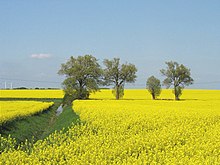
In 2012, around 36,500 people were employed in agriculture in Brandenburg in around 5,600 businesses. With a total area of around 2.95 million hectares, Brandenburg has 1,319,600 hectares of agricultural land. The average operating area of 238 hectares is very large in a Germany-wide comparison. Large farms with over 1,000 hectares cultivate over 70% of the arable land in Brandenburg. They include, for example, the Lindhorst Group and the Steinhoff Family Holding.
Brandenburg is one of the leading federal states in organic farming. In 2015, 767 producing organic farms were registered in the country. This means that 14.2 percent of the 5400 farms in the country operate ecologically. Around 136,000 hectares are registered according to the EU organic regulation. This corresponds to 12.9 percent of the organic area in the whole of Germany.
The region around Werder (Havel) is known for its fruit growing . Mostly cherries, apples and strawberries are grown. But vegetables, especially tomatoes, are also grown in the greenhouses. Two larger companies are currently selling the region's products: on the one hand, "Werder Frucht", which mainly sells juices and the fruit itself, and on the other, Werder Feinkost , which specializes in the production of ketchup, fruit wines and spreads.
energy
In 2011, gross electricity generation totaled 52,505 gigawatt hours. Of this, 31,457 GWh - almost 60 percent - were exported. With 65%, the energy from lignite makes up the largest share of electricity generation in Brandenburg; corresponding to 34,114 gigawatt hours. The gross electricity consumption in 2011 was around 21,048 GWh. The Rheinsberg nuclear power plant was established in 1960 and was the first of the German nuclear power plants to be shut down in 1990 . The Schwarze Pump power plant (power capacity 1600 MW), the Boxberg power plant (power capacity 2575 MW) and the Jänschwalde power plant (power capacity 3000 MW) are among the largest lignite power plants in Germany.
Brandenburg is an important wind energy location . In mid-2016, 3551 wind turbines with a cumulative output of 6099 MW were installed there. The wind farms in place in 2014 covered around 56% of the country's net electricity requirements. Important systems for solar power production are u. a. the Templin - Groß Dölln solar park (128 MWp ), the Brandenburg-Briest solar park (91 MWp) and the Neuhardenberg solar park (145 MWp). In 2007 around 12% of the total German biodiesel production was in Brandenburg.
In 2012, the Brandenburg state government published its draft of an “Energy Strategy 2030”. For the future energy supply, the country is relying on the expansion of renewable energies . The government wants to achieve a share of renewable energies in final energy consumption of 50 percent by 2030. The aim is to reduce greenhouse gas emissions by 72 percent compared to 1990 levels by then. The country is one of the leading German countries in terms of both the use of renewable energies and the manufacture of systems.
media
Around 65,000 employees worked in the ICT, media and creative industries in 2014. The companies in this sector generated sales of 5.3 billion euros.
The daily newspapers appear in Brandenburg: Potsdamer Latest News , Märkische Oderzeitung , Lausitzer Rundschau , Nordkurier and the Märkische Allgemeine .
The Babelsberg Film Studio in Potsdam , founded in 1911, is the world's oldest large film studio and at the same time the largest film studio in Europe in terms of area. It is best known for its legendary early films like Metropolis and The Blue Angel . Today the Babelsberg film studio is one of the leading centers for film and television productions in Europe and a location for German-American co-productions.
The Berlin-Brandenburg radio broadcasts from Potsdam-Babelsberg. The radio stations Antenne Brandenburg , Radio Fritz and Radio Eins as well as the TV programs Brandenburg aktuell and zibb are produced there. There is also the local television station PotsdamTV and the local radio station 89.2 Radio Potsdam in Brandenburg .
biotechnology
In the region around the state capital Potsdam there is a focus for research-related companies due to several scientific institutions. As part of the European metropolitan region of Berlin-Brandenburg with a total of 160 companies and 3200 direct employees in the field of biotechnology, it is one of the nationwide leading locations in this sector, according to a study in 2006.
tourism
Tourism in Brandenburg has had high growth rates since 2000 and is considered an important economic factor. In 2012, the industry had over 60,000 employees and around 11.5 million overnight stays. Tourism is determined by the diverse landscape, the historic town centers, the forest and water-rich nature parks and the sights such as the palaces and castles.
The Berlin – Usedom long-distance cycle route has been running through northern Brandenburg since 2007.
In the so-called media city of Babelsberg , in addition to Studio Babelsberg AG, there is the Filmpark Babelsberg , a theme park with a studio tour of the site as well as exhibitions, stunt shows, sets and props from numerous well-known productions from the world of film.
The Tropical Islands is about 50 km south of Berlin and is an adventure park in Halbe . The park was built in the largest self-supporting hall in the world, which spans an area of 66,000 m² (equivalent to nine football fields). In the facility, which is open all year round, there is a tropical swimming and leisure area with overnight accommodation.
Infrastructure
Brandenburg's most important main traffic routes such as railways , roads and waterways run towards Berlin in a star shape. The broadband internet access with a data transfer rate of 6 Mbit / s was allowing in 2015 for 75-95% of all households in Brandenburg. The supply quota of 50 Mbit connections was between 10 and 50%. In November 2015, 90% of the network coverage for the LTE (4G) mobile communications standard was guaranteed in Brandenburg (93% throughout Germany).
Rail transport

In rail traffic, most of the railway lines are connected by the Berlin outer ring , most of which is located in Brandenburg. After 1995, due to the sparsely populated area and the growing number of cars, a significant part of the rail infrastructure (especially smaller stations and sidings) was shut down.
The automation of level crossings has been advanced since 2000. There are currently many route sections over 20 km in length without intermediate stops (as with RE 5), since only long-running RE lines operate there. On many smaller routes, local rail passenger transport is operated by private railways; The Hanseatic Railway , the Niederbarnimer Railway and, above all, the East German Railway established themselves in Brandenburg over the course of time.
In the local public transport sector , all the transport companies in Brandenburg and Berlin have come together to form the Verkehrsverbund Berlin-Brandenburg (VBB) in order to guarantee uniform transport structures and tariffs in the region. In 2017, 1.470 billion passengers were carried.
Road traffic

The registered cars serve as an indicator of the degree of motorization in a society. Despite the falling population, the number of cars in Brandenburg is increasing. In 2004 there were 86,409 new vehicle registrations in Brandenburg. In 2014, a high of 1,343,315 cars was registered. There were 548 registered cars for every 1000 inhabitants (510 non-commercial vehicles per 1000 inhabitants). This means that the degree of motorization continues to increase and is just above the national German average.
In road traffic, almost all motorways in the state of Brandenburg start on the “ Berliner Ring ” motorway ring, Bundesautobahn 10, which mostly runs through Brandenburg. Furthermore, several federal and European roads run through the country. The motorways in Brandenburg are the A 2 (Berliner Ring / Dreieck Werder - Magdeburg - Hanover - Dortmund - Oberhausen), the A 9 (Berliner Ring / Dreieck Potsdam - Leipzig - Nuremberg - Munich), the A 10 (Berliner Ring), the A 11 (Berliner Ring / Dreieck Schwanebeck - Prenzlau - border crossing PL - Stettin / Szczecin ), the A 12 (Berliner Ring / Dreieck Spreeau - Frankfurt (Oder) - border crossing PL - Posen / Poznań - Warsaw / Warszawa ), the A 13 ( Berliner Ring / Kreuz Schönefeld - Dreieck Spreewald / A 15 - Dresden), the A 14 (Schwerin - Magdeburg - Dresden), the A 15 (Dreieck Spreewald / A 13 - Cottbus - border crossing PL - Liegnitz / Legnica - Breslau / Wrocław ), the A 19 (Dreieck Wittstock (Dosse) / A 24 - Rostock), the A 20 (Kreuz Uckermark / A 11 and B 166 - Stralsund - Rostock - Lübeck), the A 24 (Berliner Ring / Dreieck Havelland - Hamburg), the A 111 (Berliner Ring / Kreuz Oranienburg - Berlin-Reinickendorf - Dreieck Charlottenburg / Stadtring A 100), the A 113 (Berliner Ring / Kreuz Schönefeld - Dreieck Wal tersdorf - Berlin-Adlershof - Dreieck Neukölln / Stadtring A 100 ), the A 114 (Berliner Ring / Dreieck Pankow - Berlin-Pankow), the A 115 (Berliner Ring / Dreieck Nuthetal - Berlin-Zehlendorf - Dreieck Funkturm / Stadtring A 100) and the A 117 (Dreieck Waltersdorf / A 113 - Berlin-Treptow).
Shipping
The inland water transport and water transport through numerous channels are an important economic factor for parts of the country and have a regional character. The waterways are used for the transport of goods and for tourist passenger transport. There are also a large number of car ferries, for example on the Elbe and Havel.
Brandenburg's largest port is located in Wittenberge at the confluence of the Stepenitz with the Elbe .
The Niederfinow boat lift , which went into operation in 1934, is the oldest still working boat lift in Germany . It is located at the eastern end of the Oder-Havel Canal in Niederfinow / Brandenburg and overcomes the height difference of 36 meters between the apex position and the Oder position of the federal waterway Havel-Oder waterway , for which the Eberswalde waterways and shipping office is responsible. The Niederfinow Nord boat lift, which is suitable for larger ships, will be built parallel to the previous lift and will replace the old one before 2020.
Air traffic
The Berlin-Schoenefeld Airport (SXF) is by its proximity to Berlin, the largest airport in the state. The airport is operated by Flughafen Berlin Brandenburg GmbH with the partners State of Berlin, State of Brandenburg and the Federal Republic of Germany . Around 11.7 million passengers were handled there in 2016 (+37% compared to the previous year). In terms of passenger numbers, the airport was in seventh place in Germany in 2018. The main airlines that operate from Schönefeld Airport are currently Ryanair , easyJet and Norwegian Air Shuttle (as of 2019).
The new Berlin Brandenburg Airport (BER) is currently being built to the south of Berlin-Schönefeld Airport . After the closure of Berlin Airport in Tegel, this will handle all international air traffic for the Berlin-Brandenburg metropolitan region. With a passenger number of more than 40 million a year, BER will become the third largest airport in Germany.
The ILA Berlin Air Show has been taking place at the Berlin ExpoCenter Airport area in the Selchow district of Schönefeld since 2012 . The area is on the western edge of the future Berlin Brandenburg Airport . The ILA is the most important trade fair for the aerospace industry in Germany and one of the largest space fairs in the world.
There are also the larger Cottbus-Drewitz airfield and the smaller ones like the Lausitz airfield Finsterwalde / Schacksdorf and Neuhardenberg .
education
In 2015, a total of 33,407 children under the age of three were cared for in day-care centers in Brandenburg . This corresponds to a care rate of 56.8% of all children in this age group (32.9% throughout Germany).
School system
In the state of Brandenburg there were 864 schools (excluding universities) in the 2011/2012 school year, which are attended by around 220,000 students. In the 2004/2005 school year there were 327,157 students. The number of teachers remained relatively constant over the period despite the falling number of students and was around 19,000.
The Brandenburg school system is divided into a six-year elementary school , after which the pupil can switch to an upper school , comprehensive school with upper level or a grammar school .
With the upper level center, there is also a type of school that combines a technical school , technical college , vocational school and vocational high school . For pupils with special needs, there are also special schools with different focuses.
In 2014, 10,077 new training contracts were concluded in Brandenburg. In the same year there were a total of 26,265 trainees in the country. Most of them are teaching in the field of industry and trade. Crafts, agriculture, housekeeping, the liberal professions and the public service are also popular training areas.
Colleges

In the state of Brandenburg there are five universities , six universities of applied sciences , which are allowed to call themselves universities in the state of Brandenburg, as well as two administrative universities. The largest university is the University of Potsdam , where almost 20,000 students are taught. In addition to this, the European University Viadrina in Frankfurt (Oder), the Brandenburg Technical University Cottbus-Senftenberg , the Babelsberg Film University and the Brandenburg Medical School in Neuruppin and Brandenburg an der Havel are university-ranked. The medical college, founded in 2014, is the only private one, the other four are state universities.
The largest technical college in Brandenburg is the Technical University of Applied Sciences Wildau with over 4000 students. In addition to this further public state universities of applied sciences are the Technical University of Brandenburg , the University for Sustainable Development Eberswalde and the University of Applied Sciences Potsdam . The Elstal Theological Seminar (University of Applied Sciences) is a church, the University of Applied Sciences for Sport and Management Potsdam is a private educational institution. The Clara Hoffbauer University of Applied Sciences in Potsdam has a private church sponsor. In addition to these, there are the two administrative colleges, the Brandenburg College of Finance in Königs Wusterhausen and the Brandenburg Police College in Oranienburg.
Brandenburg does not charge any fees for studying in the state . Few subjects have a numerus clausus , and due to the relatively young age of many universities, there are particularly modern learning and working conditions. Either the Potsdam Student Union or the Frankfurt (Oder) Student Union are responsible for students at all universities . In the 2012/2013 winter semester , a maximum of 52,031 enrolled students was reached.
research
Each of the large German research communities is represented in the state of Brandenburg. There are a total of four facilities of the Hermann von Helmholtz Association of German Research Centers, eight institutes of the Leibniz Association, three institutes of the Max Planck Society (MPG) and three facilities of the Fraunhofer Society (FhG). The close cooperation between research institutions and universities in the state is important. Corresponding agreements between the institutions enable complementary developments.
The following institutes have been located in the Albert Einstein Science Park since 1992 : the German Research Center for Geosciences , the Leibniz Institute for Astrophysics Potsdam , the Potsdam Research Center of the Alfred Wegener Institute for Polar and Marine Research , the Potsdam Institute for Climate Impact Research and the Meteorological Institute Potsdam Observatory of the German Weather Service . In the 1990s, many historic buildings were extensively renovated and numerous new buildings were built.
The Hasso Plattner Institute for Software Systems Engineering (HPI) is an affiliated institute of the University of Potsdam and was in Potsdam-Babelsberg settled. It was created in 1998 through a partnership with the State of Brandenburg. Namesake of the Institute is the SAP founder and chairman Hasso Plattner .
Culture

For a long time, the state of Brandenburg was the historical core of the Prussian state and thus a center of attraction for immigrants. The policy of tolerance in religious issues since the Edict of Potsdam has resulted in a strong cultural influence among immigrants, especially the French Huguenots . Numerous representative palaces, castles, churches and generously designed parks have been preserved from the various epochs.
In addition to the national holidays , Easter Sunday , Pentecost Sunday and Reformation Day are public holidays in Brandenburg .
There are numerous personalities associated with Brandenburg. One of them is the writer Theodor Fontane , who made a significant literary homage to his homage with his hikes through the Mark Brandenburg . Heinrich von Kleist worked in the literary epochs of the Weimar Classic and Romantic periods. Karl Friedrich Schinkel , Wilhelm von Humboldt and numerous members of the royal-imperial family of the Hohenzollern , including King Friedrich Wilhelm III , were also born in Brandenburg and worked there . and Emperor Friedrich III. An honorary citizen of the city of Brandenburg an der Havel is the humorist Vicco von Bülow, who became famous under his stage name Loriot .
The film and television production company UFA , based in Potsdam, is an important actor in popular culture . The TV formats, shows and series created by the UFA come to more than 4000 hours of television programming per year, broadcast by 20 German channels.
World heritage and architecture

The palaces, gardens and parks of the so-called “ Potsdam cultural landscape” were added to the list of UNESCO World Heritage Sites in 1990. Since then, Park Sanssouci (the summer residence of Frederick the Great ), Neuer Garten , Babelsberg , Glienicke and the Pfaueninsel with their castles, as well as Sacrow Palace and Park with the Church of the Savior since 1992 and the Alexandrowka colony since 1999, have been part of the World Heritage Sites. Overall, the architectural ensemble extends over around 500 hectares of parkland with 150 buildings from the period from 1730 to 1916. This cultural landscape is therefore the largest of the German World Heritage Sites.
The “Cities with Historic Town Centers” working group of the State of Brandenburg was founded in 1992 with the aim of renovating the historic town centers in their building fabric and filling them with new life. Currently (as of 2007) 31 cities belong to the working group. The oldest cities include Brandenburg an der Havel (first mentioned in 948), Potsdam (993), Beelitz or Bad Belzig (997), Doberlug (1005) and Jüterbog (1007).
Other important buildings in Brandenburg are Boitzenburg Castle , the former ancestral home of the von Arnim family , whose landscape park was designed in the English style by Peter Joseph Lenné . The Neuhardenberg Castle is known by annual music events. The Rheinsberg Castle , a moated castle , has become particularly known for the works of Kurt Tucholsky and Theodor Fontane . Meseberg Castle , a baroque castle in Gransee , has been the official guest house of the German federal government since 2007. The Einstein Tower of the Astrophysical Institute , built in 1921, served to experimentally confirm the theory of relativity . It is considered to be one of the outstanding examples of expressionist architecture and incorporates elements of Art Nouveau .
Theater and art
The Cottbus State Theater is the only multi-branch theater in the state of Brandenburg. The opera / ballet, drama and a philharmonic orchestra have their own ensembles. The house was opened as a municipal theater in 1908 and was named a state theater in 1991. Since 2004 it has been part of the Brandenburg Cultural Foundation Cottbus. The State Theater's venues are the Großer Haus am Schillerplatz, the Kammerbühne and the Ströbitz theater barn.
The Hans Otto Theater is the theater of the state capital Potsdam. Since September 2006 his ensemble has been playing in the Neues Theater, which is synonymous with the Hans Otto Theater as the seat of the house and is located on the Schiffbauergasse on the banks of the Tiefen See. Other venues of the theater are the neighboring historic riding arena and the baroque palace theater in the New Palais of Sanssouci .
The art museum Dieselkraftwerk Cottbus shows modern art of the genres painting, sculpture / object, graphics, photography and poster art on around 1,250 square meters of exhibition space. Overall, the museum houses a collection of more than 23,000 objects. Since the mid-1990s, exhibitions and acquisitions on the subject of landscape / space / nature / environment have been the focus of the collection. Concerts, theater events and the use of a creative workshop complete the exhibition program. The art museum is part of the Brandenburg Cultural Foundation Cottbus. In addition, there is a lively art scene in Brandenburg with fixed events such as the “Open Ateliers” day at the beginning of May, the award of the Brandenburg Art Prize by the Märkische Oderzeitung and the Kunstloose days in the Oderbruch.
music
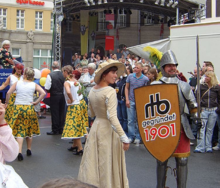
The Brandenburg Symphony Orchestra include the oldest existing ensembles of the country's outstanding cultural institutions in Brandenburg. The orchestra was founded in 1810 by high-ranking Prussian military musicians from the fusilier and grenadier regiments. Their symphony concerts and special concerts, which are regularly sold out, are fixed items in the cultural life of the entire region. The orchestra not only acts as a symphony orchestra , but also in opera performances and it has been playing in productions of the Rheinsberg Castle Chamber Opera for years . The symphonic orchestras make regular national and international guest appearances.
The Philharmonic Orchestra of the Cottbus State Theater was founded in 1912 as the theater's own orchestra. The orchestra mainly acts in operas, operettas, philharmonic concerts and chamber concerts.
The Brandenburg State Orchestra Frankfurt (Oder) is the only pure concert orchestra in Brandenburg, it offers various concert series in Frankfurt.
The German Film Orchestra Babelsberg is an orchestra based in the Babelsberg Studio in Potsdam. In the film and television sector, over 220 film music productions were recorded in the company's own studios. There are also collaborations with the neighboring Babelsberg Film University .
The Jacaranda Ensemble , Keimzeit and Subway to Sally are among the well-known music groups from Brandenburg. Successful musicians born in Brandenburg are u. a. the singer Jürgen Drews , guitarist Richard Kruspe (Rammstein) and music producer Paul van Dyk .
Events
The Tree Blossom Festival in Werder is one of the largest and most famous events in the state of Brandenburg . It attracts over 500,000 visitors every year, making it one of the largest folk festivals in Germany. The first festival took place in March 1879 and has been celebrated regularly since the trees are in bloom.
Also well known is the Potsdam Palace Night , which is usually sold out very early and which takes place annually in Sanssouci Park . The event is accompanied by performers, musicians and citizens in baroque costumes, classical music festivals and a big fireworks display at the end.
In addition, numerous other regional events take place, such as the Havel Festival in the city of Brandenburg an der Havel with 200,000 visitors, the Singers Festival in Finsterwalde with over 100,000 visitors every two years, the Kleist Festival in Frankfurt (Oder) and the Bassewitz Festival in Kyritz .
With the International Film Festival Potsdam and the sehsüchten , the largest student film festival in Europe, there are two film festivals in Potsdam ; other film festivals are at home in Bad Saarow , Cottbus , Eberswalde and Lausitz .
Since 1998, various projects within the state on one topic have been funded under the umbrella brand Kulturland Brandenburg . In the past, these included landscape and gardens (2004), 1000 years of Christianity (2005), building culture (2006), focus on water (2007) and provinces and metropolitan areas (2008). The state has been celebrating Brandenburg Day on a regular basis since 1995 . It took place for the first time on September 30, 1995 in Cottbus . In 2016 Hoppegarten was the venue.
kitchen
Brandenburg cuisine is more rural and rustic. Fresh, regional products are preferred. The Brandenburg cuisine is very rich in fish because of the numerous large and small bodies of water, especially pike, pikeperch, eel and carp. Game dishes are also quite typical. Ever since Frederick the Great helped the potato to break through in Brandenburg, it has been an indispensable part of local cuisine. A specialty of Niederlausitz is plinsen , a form of pancake . Uckermark specialties are Wruken (turnip stew) and Kloppschinken (Kloppschinken).
The best-known Brandenburg specialties include Beelitz asparagus , Spreewald gherkins and quark with linseed oil in the Lower Lusatian style, which are usually served with jacket potatoes. The Neuzelle monastery brewery is known nationwide for its black beer , while fruit wines and fruit brandies are produced in and around Werder (Havel) . The ice cream creation Fürst-Pückler , which consists of the three classic types of strawberry, vanilla and chocolate, was created in Upper Lusatia in the Brandenburg region . It is named after Hermann von Pückler-Muskau and comes from a Prussian court cook who dedicated this three-layer ice cream to the prince in 1839.
In the renowned Michelin Guide 2016 , the three restaurants Kochzimmer ( Beelitz ), Friedrich Wilhelm (Potsdam) and 17fuffzig ( Burg im Spreewald) have been awarded one star in Brandenburg .
Sports
One of the most famous sports clubs in the state of Brandenburg is the FC Energie Cottbus, one of its greatest successes, in addition to having been in the 1st and 2nd Bundesliga for many years , reaching the DFB Cup final in 1997, as well as 1st place. FFC Turbine Potsdam , who has won several German championships and cups in women's football , as well as being the winner of the UEFA Women's Cup . In handball , the Frankfurt Handball Club was a well-known club.

An Olympic base is located in the state of Brandenburg with three sub-locations in Cottbus, Frankfurt (Oder) and Potsdam. Athletes from the bases were able to win medals at the Olympic Games, particularly in the disciplines of rowing, canoeing and cycling. There are also several elite sports schools in the country.
The most successful athletes from Brandenburg include the boxers Henry Maske and Axel Schulz , the discus throwers Robert Harting , Christoph Harting and the swimmer and Olympic champion Britta Steffen . The canoe racer Birgit Fischer from Brandenburg an der Havel is the most successful German Olympic athlete in sports history with eight gold and four silver medals. The judoka Yvonne Bönisch , the judoka and sumo fighter Sandra Köppen-Zuckschwerdt , the shot putter Udo Beyer and the speedway professional Christian Hefenbrock are also known.
At the Lausitzring find motorsport events such as the annually held races in the DTM instead. At the former military airport Groß Dölln and at the Spreewaldring Training Center there is a driver safety center with a race track. There are also dirt track races in Lübbenau , Speedway in Wolfslake and in Wittstock .
See also
literature
- Matthias Asche: New settlers in the devastated country - Coping with the aftermath of the war, migration control and denominational politics in the light of state reconstruction - The Mark Brandenburg after the wars of the 17th century. Aschendorff Verlag, Münster 2006, ISBN 3-402-00417-8 .
- Friedrich Beck , Eckart Henning (ed.): Brandenburgisches Biographisches Lexikon (BBL). Verlag für Berlin-Brandenburg, Potsdam 2002, ISBN 3-935035-39-X .
- Iris Berndt: Saxon Brandenburg. A search for clues. Sandstein Verlag, Dresden 2014, ISBN 978-3-95498-070-3 .
- Christiane Büchner, Jochen Franzke: The state of Brandenburg. Small political geography. 4th revised edition. Brandenburg State Center for Political Education, Potsdam 2005, ISBN 3-932502-09-4 .
- Lieselott Enders , Klaus Neitmann (Ed.): Brandenburg State History Today. Verlag für Berlin-Brandenburg, Potsdam 1999, ISBN 3-930850-72-9 .
- Theodor Fontane : Walks through the Mark Brandenburg in 8 volumes. Edited by Gotthard Erler and Rudolf Mingau. Construction Verlag, Berlin 1997, ISBN 3-351-03104-1 .
- Gerd Heinrich (Ed.): Handbook of the historical sites of Germany . Volume 10: Berlin and Brandenburg (= Kröner's pocket edition . Volume 311). Kröner, Stuttgart 1973, ISBN 3-520-31101-1 .
- Gerd Heinrich: Brandenburg culture atlas. Historical maps - an overview of the history of the Mark. 2nd revised edition. Berlin 2006, ISBN 3-00-019684-6 .
- Jakob Lempp: Parties in Brandenburg. Berlin 2008, ISBN 978-3-937233-48-2 .
- Ingo Materna , Wolfgang Ribbe (ed.): Brandenburg history . Akademie Verlag, Berlin 1995, ISBN 3-05-002508-5 .
- Nils Meyer: Empty spaces - dealing with monuments as a process of creating meaning using the example of castles and mansions in Brandenburg . Jovis, Berlin 2009, ISBN 978-3-86859-081-4 .
- Klaus Neitmann , Jürgen Theil (ed.): The origin of the Brandenburgers. Social and mental history contributions to the population of Brandenburg from the high Middle Ages to the 20th century. Verlag für Berlin-Brandenburg, Potsdam 2001, ISBN 3-935035-11-X .
- Lutz Partenheimer : The emergence of the Mark Brandenburg. With a Latin-German source attachment. 1st and 2nd edition. Cologne / Weimar / Vienna 2007.
- Pestalozzi Association of the Province of Brandenburg (Ed.): The Province of Brandenburg in words and pictures. Published by Julius Klinkhardt, Berlin / Frankfurt am Main 1981, DNB 820110361 .
- Johannes Schultze : The Mark Brandenburg . Foreword by Werner Vogel. 4th edition, Duncker & Humblot, Berlin 2011, ISBN 978-3-428-13480-9 (reprint of volumes 1 to 5 from 1961 to 1969 in one book).
- Antje Rávic Strubel : Instructions for use for Potsdam and Brandenburg . Piper Taschenbuch, Munich 2012, ISBN 978-3-492-27604-7 .
- Ingrid Reisinger, Walter Reisinger: Well-known, unknown and forgotten manor houses and manor houses in the state of Brandenburg. Stapp Verlag, Berlin 2013, ISBN 978-3-87776-082-6 .
- August Heinrich von Borgstede: Statistical-topographical description of the Kurmark Brandenburg. First part. Printed and published by Johann Friedrich Unger, Berlin 1788. (Reprint: Potsdam 2013, ISBN 978-3-88372-051-7 )
- Frank Mangelsdorf (Ed.): Land Brandenburg. Then and now. Culturcon / Märkische Oderzeitung , Berlin 2010, ISBN 978-3-941092-43-3 .
Web links
|
Further content in the sister projects of Wikipedia:
|
||
|
|
Commons | - multimedia content |
|
|
Wiktionary | - Dictionary entries |
|
|
Wikisource | - Sources and full texts |
|
|
Wikinews | - News |
|
|
Wikivoyage | - Travel Guide |
- Official website of the state of Brandenburg
- Official tourism website of the state of Brandenburg
- Official site of the state of Brandenburg
- Official website for the 850th anniversary of the Mark Brandenburg
- Brandenburg historical landscape
- Culture portal for the state of Brandenburg
- Regional studies of Brandenburg . A portal of the Brandenburg State Center for Political Education
- Publication sheets of the state of Brandenburg
- Land surveying and geographic base information Brandenburg
- Literature from and about Brandenburg in the catalog of the German National Library
- Link catalog on Brandenburg at curlie.org (formerly DMOZ )
Individual evidence
- ↑ Elisabeth Berner: Vertreders ut de Länner Bundesraat för Nedderdüütsch, accessed on 11 October 2016th
- ↑ a b Constitution of the State of Brandenburg - Article 25 BbgVerf “Rights of the Sorbs / Wends” , accessed on January 18, 2016.
- ↑ European Charter for Regional or Minority Languages , accessed on January 18, 2016.
- ↑ Elisabeth Berner: Vertreders ut de Länner . Bundesraat för Nedderdüütsch, accessed on January 18, 2016.
- ↑ Population in the State of Brandenburg according to municipalities, offices and municipalities not subject to official registration on December 31, 2019 (XLSX file; 223 KB) (updated official population figures) ( help on this ).
- ↑ Unemployment rates in July 2020 - countries and districts. In: statistik.arbeitsagentur.de. Statistics from the Federal Employment Agency, accessed on August 11, 2020 .
- ^ Gross domestic product of Brandenburg since 1991 statista.com, accessed on January 9, 2018.
- ↑ Source: destatis, Debt of Public Budgets on December 31, 2015 ( Memento of the original from July 21, 2016 in the Internet Archive ) Info: The archive link was inserted automatically and has not yet been checked. Please check the original and archive link according to the instructions and then remove this notice.
- ^ The state of Brandenburg in numbers and maps. (PDF) (No longer available online.) Land surveying and geographic base information Brandenburg, 2016, archived from the original on August 16, 2017 ; accessed on January 27, 2018 . Info: The archive link was inserted automatically and has not yet been checked. Please check the original and archive link according to the instructions and then remove this notice.
- ↑ Berlin-Brandenburg Capital Region , www.berlin-brandenburg.de, accessed on January 17, 2016.
- ↑ Gerd W. Lutze (author), Lars Albrecht, Joachim Kiesel, Martin Trippmacher (landscape visualization): Natural spaces and landscapes in Brandenburg and Berlin. Structure, genesis and use . Be.Bra Wissenschaft Verlag, Berlin 2014, ISBN 978-3-95410-030-9 , an overview of the natural space and landscape in Brandenburg and Berlin. Overview - Natural area and landscape structure Brandenburg and Berlin, p. 21.
- ↑ Deep-lying deposits in Brandenburg (PDF; 1.5 MB), State Office for Mining, Geology and Raw Materials Brandenburg, accessed on January 18, 2016.
- ↑ Information on the climate from: M. Hendl: The climate of the North German Lowland. In: H. Liedtke, J. Marcinek (Ed.): Physical geography of Germany . Gotha 1994, ISBN 3-623-00840-0 .
- ↑ Climate change in Brandenburg: The risk of forest fires is increasing again. In: tagesspiegel.de . April 14, 2019, accessed April 14, 2019 .
- ↑ Ulrike Fokken: Forest and forest fires in Brandenburg: A country hangs on the needle . In: The daily newspaper: taz . October 2, 2018, ISSN 0931-9085 ( taz.de [accessed October 16, 2018]).
- ↑ a b German Weather Service (2019). Climate report Brandenburg. https://lfu.brandenburg.de/cms/media.php/lbm1.a.3310.de/Klimareport_Brandenburg_2019.pdf
- ↑ https://www.bz-berlin.de/berlin/umland/so-hart-trifft-der-klimawandel-brandenburg
- ↑ Brandenburg - The vastness is so close. (No longer available online.) Brandenburg State Government, State Chancellery, archived from the original on January 12, 2016 ; accessed on January 18, 2016 . Info: The archive link was inserted automatically and has not yet been checked. Please check the original and archive link according to the instructions and then remove this notice.
- ^ Brandenburg - The birthplace of Prussia. (No longer available online.) ZDF , March 5, 2008, formerly in the original ; accessed on January 18, 2016 . ( Page no longer available , search in web archives ) Info: The link was automatically marked as defective. Please check the link according to the instructions and then remove this notice.
- ↑ Nature conservation and landscape management www.mlul.brandenburg.de/, accessed on January 18, 2016.
- ↑ Rare terns breed in the National Park Unteres Odertal Märkische Oderzeitung from July 3, 2006.
- ↑ National Park, Biosphere Reserves and Nature Parks rbb, accessed on January 28, 2016.
- ^ Lutz Partenheimer: The emergence of the Mark Brandenburg . Böhlau Verlag, Cologne 2007, ISBN 978-3-412-17106-3 , The subjection of the Hevellers by King Heinrich I (928 / 929-936), pp. 17-24.
- ↑ a b Lutz Partenheimer: The emergence of the Mark Brandenburg . Böhlau Verlag, Cologne 2007, ISBN 978-3-412-17106-3 , The permanent integration of the Slavs under Emperor Otto I (936–973), pp. 25–34.
- ^ Gertraut Eva Schrage: Brandenburg history . Akademie Verlag, Berlin 1995, ISBN 3-05-002508-5 , Prehistory and Early History. Teutons - Slavs - Germans, pp. 72-184, Mark des Gero: p. 80.
- ^ Karlheinz Blaschke : Lexicon of the Middle Ages. Volume VI. Lukasbilder to Plantagenêt . In: Norbert Angermann to Klaus Zernack (Ed.): Lexicon of the Middle Ages . (LexMA). 9 volumes. Deutscher Taschenbuchverlag, Munich 2002, ISBN 3-423-59057-2 , Meißen. II. Diocese, Sp. 478-479.
- ^ Lutz Partenheimer: The emergence of the Mark Brandenburg . Böhlau Verlag, Cologne 2007, ISBN 978-3-412-17106-3 , The Wends uprising of 983 and the attempts to recapture the Brandenburg, pp. 35–44.
- ^ Lutz Partenheimer: The emergence of the Mark Brandenburg . Böhlau Verlag, Cologne 2007, ISBN 978-3-412-17106-3 , The Brandenburg Area from the Cessation of the Saxon Attempts to Recapture to Their Resumption (around 1000 to the beginning of the 12th century), pp. 45–51.
- ^ A b c Helmut Assing : Brandenburg history . Akademie Verlag, Berlin 1995, ISBN 3-05-002508-5 , Die Landesherrschaft der Askanier, Wittelsbacher and Luxemburger (middle of the 12th to the beginning of the 15th century), pp. 85–168.
- ^ Heinz Teichmann: From Lebus to Fürstenwalde. Brief history of the medieval diocese of Lebus (1124–1555 / 98) . St. Benno Buch- und Zeitschriftenverlag, Leipzig 1991, ISBN 3-7462-0532-8 , I. Diocese and Land of Lebus at the time of Polish rule (until around 1250). 1. How the diocese was founded, pp. 15-18.
- ^ Lutz Partenheimer: The emergence of the Mark Brandenburg . Böhlau Verlag, Cologne 2007, ISBN 978-3-412-17106-3 , The early Ascanians and the first steps to reclaim the Heveller area and reestablish the diocese of Brandenburg. Origin and name of the House of Askanien-Anhalt, pp. 53–56.
- ^ Lutz Partenheimer: The emergence of the Mark Brandenburg . Böhlau Verlag, Cologne 2007, ISBN 978-3-412-17106-3 , The takeover of the Heveller principality by Albrecht the Bear and the “foundation” of the Mark Brandenburg, pp. 65–76, here pp. 66–68, 72–76 .
- ^ Lutz Partenheimer: The emergence of the Mark Brandenburg . Böhlau Verlag, Cologne 2007, ISBN 978-3-412-17106-3 , outlook on the further development of the Mark Brandenburg and the Ascanians. The expansion of the young Mark Brandenburg, pp. 78–81.
- ↑ a b Johannes Schultze: The Mark Brandenburg. Second volume . 4th edition, Duncker & Humblot, Berlin 2011, ISBN 978-3-428-13480-9 , II. The mark under the Luxembourg house. 1. Emperor Karl IV. (1373-1378), pp. 161-175, here pp. 161-162.
- ^ Christian Gahlbeck, Gertraud Eva Schrage: Chorin. Cistercians. In: Heinz-Dieter Heimann , Klaus Neitmann, Winfried Schich and others (eds.): Brandenburgisches Klosterbuch. Handbook of the monasteries, pens and commander by the mid-16th century. Volumes I and II (= Klaus Neitmann on behalf of the Brandenburg Historical Commission and in connection with the Brandenburg State Main Archive [Hrsg.]: Brandenburgische Historische Studien . Volume 14). Be.Bra Wissenschaft Verlag, Berlin 2007, ISBN 978-3-937233-26-0 , 2nd historical outline. 2.1 History of the monastery and monastery, pp. 329–333, here p. 330.
- ↑ Johannes Schultze: The Mark Brandenburg. First volume . 4th edition, Duncker & Humblot, Berlin 2011, ISBN 978-3-428-13480-9 , 18th Otto IV. And Hermann (1300-1308), pp. 198–205, Mark Lausitz: pp. 199–200.
- ↑ Marek Wejwoda: plaything of powerful neighbors. "The Lausitz" in the 14th century. In: Heinz-Dieter Heimann , Klaus Neitmann , Uwe Tresp (eds.): The Lower and Upper Lusatia - Contours of an integration landscape. Volume I: Middle Ages (= The Lower and Upper Lusatia - Contours of an Integration Landscape). 3 volumes, Lukas Verlag für Kunst- und Geistesgeschichte, Berlin 2013, ISBN 978-3-86732-160-0 , pp. 191–203, here pp. 192–194.
- ^ Constitution for the Mark Brandenburg of February 6, 1947.
- ↑ Population - Brandenburg ( Memento of the original from September 21, 2013 in the Internet Archive ) Info: The archive link was inserted automatically and has not yet been checked. Please check the original and archive link according to the instructions and then remove this notice. Federal and state statistical offices, accessed on January 18, 2016.
- ↑ Berliners flee to Brandenburg Tagesspiegel from January 21, 2008, accessed on January 16, 2016.
- ↑ Structural Atlas Brandenburg Subject Population Map population density of the State Office for Building and Transport Brandenburg.
- ↑ More births in Brandenburg again ( memento of the original from January 13, 2016 in the Internet Archive ) Info: The archive link was automatically inserted and not yet checked. Please check the original and archive link according to the instructions and then remove this notice. Märkische Allgemeine from December 16, 2015, accessed on January 13, 2016.
- ↑ Share of the foreign population in the total population in Brandenburg from 1999 to 2015 , statista, accessed on October 31, 2017.
- ↑ 145,000 people with a migration background , Märkische Allgemeine, accessed on January 31, 2017.
- ^ Law on the structuring of the rights of the Sorbs / Wends in the state of Brandenburg. State government of Brandenburg (§ 14 SWG - "Proclamation"), accessed on January 16, 2016 .
- ^ Brandenburg cultural portal. (No longer available online.) Archived from the original on August 6, 2004 ; accessed on January 16, 2016 .
- ↑ Life expectancy in Germany by federal state and gender in 2015/2017. Retrieved October 22, 2019 .
- ↑ BBSR Homepage - Federal Institute for Building, Urban and Spatial Research (BBSR) - Research and policy advice - Where life expectancy is highest in Germany. Retrieved October 22, 2019 .
- ↑ Birth rate - children per woman in Germany by federal state in 2017. Accessed on October 28, 2019 .
- ↑ a b Berlin-Brandenburg Statistics Office , accessed on October 17, 2010.
- ↑ Population status - further reporting periods ( memento of the original from September 16, 2012 in the Internet Archive ) Info: The archive link was inserted automatically and has not yet been checked. Please check the original and archive link according to the instructions and then remove this notice. Office for Statistics Berlin-Brandenburg from January 24, 2010.
- ↑ Population in the state of Brandenburg on April 30, 2011 according to municipalities, offices and municipalities not subject to office ( Memento of the original from November 20, 2012 in the Internet Archive ) Info: The archive link was automatically inserted and not yet checked. Please check the original and archive link according to the instructions and then remove this notice. (PDF; 40 kB) Berlin-Brandenburg Statistics Office, accessed on January 16, 2016.
- ↑ a b Description of the territorial units contained in GV-ISys Federal Statistical Office, accessed on January 18, 2016.
- ^ Helmut Schönfeld: The Low German language in the states of Saxony-Anhalt and Brandenburg . In: Low German Yearbook. 114, 1991, pp. 175-201.
- ↑ Lower Sorbian - linguistic structure between Cottbus and Calau , sorbe.de, accessed on January 18, 2016.
- ^ Law on the structuring of the rights of the Sorbs / Wends in the state of Brandenburg , Article 8, paragraph 2; accessed on June 8, 2017.
- ↑ Religious affiliation of Germans by federal state in 2011. In: statista. 2011, accessed January 18, 2016 .
- ↑ a b The small Brandenburg statistics 2015. In: statistik-berlin-brandenburg.de. Office for Statistics Berlin-Brandenburg, accessed on January 18, 2016 (PDF).
- ↑ Website of the New Apostolic Church Berlin-Brandenburg under leadership , accessed on October 15, 2018
- ↑ Religious Education - Humanistic Life Studies ( Memento of the original from April 19, 2012 in the Internet Archive ) Info: The archive link has been inserted automatically and has not yet been checked. Please check the original and archive link according to the instructions and then remove this notice. MBJS, accessed January 18, 2016.
- ↑ school subject Humanist Lebenskunde HVD, accessed on 18 January 2016th
- ↑ Humanistic Life Studies in Brandenburg , Humanistic Press Service, accessed on January 7, 2016.
- ↑ Humanistischer Verband Berlin-Brandenburg Official homepage, accessed on January 18, 2016.
- ↑ Humanistic Regional Association East Brandenburg e. V. Official homepage, accessed on January 18, 2016.
- ↑ Evolutionary Humanists Berlin-Brandenburg Official Homepage, accessed on January 18, 2016.
- ^ Authorities directory service portal of the state administration, accessed on January 16, 2016.
- ↑ New state government constituted under the leadership of Prime Minister Woidke. State government of Brandenburg, November 20, 2019, accessed on December 22, 2019 .
- ↑ Law on the organization of the state administration bravors.brandenburg de, accessed on January 18, 2016.
- ↑ Organization of the immediate state administration ( memento of the original from January 18, 2016 in the Internet Archive ) Info: The archive link was inserted automatically and has not yet been checked. Please check the original and archive link according to the instructions and then remove this notice. (PDF) MIK, accessed on January 18, 2016.
- ↑ The State Office for Schools and Teacher Training , accessed on January 18, 2016.
- ^ Bundeswehr current operations
- ↑ Gross domestic product - in current prices - 1991 to 2014 ( Memento of the original from December 17, 2015 in the Internet Archive ) Info: The archive link was inserted automatically and has not yet been checked. Please check the original and archive link according to the instructions and then remove this notice. Federal and state statistical offices, accessed on January 18, 2016.
- ↑ Konjunkturtelegramm Land Brandenburg ( Memento of the original from January 27, 2016 in the Internet Archive ) Info: The archive link was inserted automatically and has not yet been checked. Please check the original and archive link according to the instructions and then remove this notice. (PDF) Ministry for Economic Affairs and Energy of the State of Brandenburg, accessed on January 27, 2016.
- ↑ Eurostat Eurostat, accessed on January 18, 2016.
- ↑ 2014 GDP per capita in 276 EU regions , Eurostat News Release 2016, accessed on March 1, 2016.
- ↑ Unemployment rate drops to its lowest level since 1991. rbb.de, accessed on June 30, 2018 .
- ↑ Employees subject to social security contributions by municipality, districts with commuter data statistics from the Federal Employment Agency in December 2013, accessed on January 18, 2016.
- ↑ Census database 2011 Census, accessed on January 16, 2016.
- ↑ Brandenburg's largest company (PDF), Märkische Allgemeine dated August 24, 2012, accessed on January 15, 2016.
- ↑ The 100 largest German credit institutions (PDF), banking association. de of August 2013, accessed on January 16, 2016.
- ↑ The Vattenfall Power Plants Vattenfall, accessed on January 18, 2016.
- ↑ Profile of the Brandenburg agricultural and food industry ( memento of the original from January 16, 2016 in the Internet Archive ) Info: The archive link was inserted automatically and has not yet been checked. Please check the original and archive link according to the instructions and then remove this notice. , Ministry of Infrastructure and Regional Planning of January 17, 2013, accessed on January 16, 2016.
- ↑ Land Use Survey 2012 MLUL, accessed on January 18, 2016.
- ↑ The German agricultural giants . In: Der Tagesspiegel , August 12, 2013, accessed on October 31, 2017.
- ↑ Brandenburg is top in organic farming , proplanta from January 17, 2016, accessed on January 19, 2016.
- ↑ Status of the onshore wind energy expansion in Germany, as of June 30, 2016 ( Memento of the original from July 30, 2016 in the Internet Archive ) Info: The archive link was automatically inserted and not yet checked. Please check the original and archive link according to the instructions and then remove this notice. . Website of the Deutsche Windguard. Retrieved July 31, 2016.
- ↑ Use of wind energy in Germany (PDF) Status: December 31, 2014. DEWI-Magazin 46. Accessed on July 31, 2016.
- ↑ Biodiesel ( Memento of the original from January 18, 2016 in the Internet Archive ) Info: The archive link was inserted automatically and has not yet been checked. Please check the original and archive link according to the instructions and then remove this notice. MLUL, accessed January 18, 2016.
- ↑ Energy Strategy 2030 (PDF), MWE, accessed on January 18, 2016.
- ↑ Comparison of the federal states of renewable energies - results of the Renewable Energy Agency, accessed on January 18, 2016.
- ↑ Brandenburg can also do business . In: Tagesspiegel , June 25, 2015, accessed on January 15, 2016.
- ↑ Potsdam.de - Excellent development potential for biotech companies. (No longer available online.) Archived from the original on August 28, 2006 ; accessed on January 16, 2016 .
- ^ Development and importance of the Brandenburg-specific clusters of food industry, plastics and chemistry, metal and tourism in the state of Brandenburg 2008–2012. (PDF) (No longer available online.) Archived from the original on September 3, 2014 ; accessed on January 16, 2016 . Info: The archive link was inserted automatically and has not yet been checked. Please check the original and archive link according to the instructions and then remove this notice.
- ↑ Brandenburg Tourism - Sustainable and Innovative ( Memento of the original from January 18, 2016 in the Internet Archive ) Info: The archive link was inserted automatically and has not yet been checked. Please check the original and archive link according to the instructions and then remove this notice. MWE of March 26, 2016, accessed on January 18, 2016.
- ↑ Half past nine in the morning in Germany Die Zeit , May 15, 2015, accessed on January 29, 2016.
- ↑ Broadband connection also for Brandenburg ( page no longer available , search in web archives ) Info: The link was automatically marked as defective. Please check the link according to the instructions and then remove this notice. . On rbb , accessed on 17 January 2016th
- ↑ Stock of motor vehicles and motor vehicle trailers by municipalities (FZ 3) Kraftfahrt-Bundesamt, accessed on January 18, 2016.
- ↑ The new Niederfinow ship lift is due to open in 2019 . Nordkurier, accessed June 30, 2018.
- ↑ Berlin Airports increase their passenger numbers by eleven percent in 2016 airliners.de, accessed on October 31, 2017.
- ↑ Current statistical data on day care , Das Kita-Handbuch, accessed on January 13, 2016.
- ↑ Vocational training time series statistics Berlin Brandenburg, accessed on January 29, 2016.
- ↑ Students at universities (PDF) Federal Statistical Office of September 26, 2013, accessed on January 23, 2016.
- ↑ 100 years of Ufa - German dream factory in the TV format Die Welt from August 10, 2017, accessed on November 1, 2017.
- ↑ UNESCO World Heritage Site since 1990 Prussian Palaces and Gardens Foundation Berlin-Brandenburg, accessed on January 18, 2016.
- ↑ Staatstheater Cottbus ( Memento of the original from February 19, 2014 in the Internet Archive ) Info: The archive link was inserted automatically and has not yet been checked. Please check the original and archive link according to the instructions and then remove this notice. Official homepage, accessed January 18, 2016.
- ^ Institution - Museum dkw, accessed on January 18, 2016.
- ↑ Das Orchester - Geschichte ( Memento of the original from March 25, 2014 in the Internet Archive ) Info: The archive link was inserted automatically and has not yet been checked. Please check the original and archive link according to the instructions and then remove this notice. Staatstheater Cottbus, accessed on January 18, 2016.
- ↑ Tourismus Marketing Brandenburg - Filmorte / Filmfestivals TMB / www.reiseland-brandenburg.de, accessed on March 7, 2016.
- ↑ Brandenburg has three star restaurants ( memento of the original from January 19, 2016 in the Internet Archive ) Info: The archive link was automatically inserted and not yet checked. Please check the original and archive link according to the instructions and then remove this notice. Märkische Allgemeine from November 12, 2015, accessed on January 19, 2016.
- ↑ Brandenburg Olympic Training Center www.osp-brandenburg.de, accessed on January 28, 2016.
- ↑ The temptress. Berliner Zeitung on April 16, 2012, accessed on January 18, 2016.
Coordinates: 52 ° 28 ' N , 13 ° 1' E

